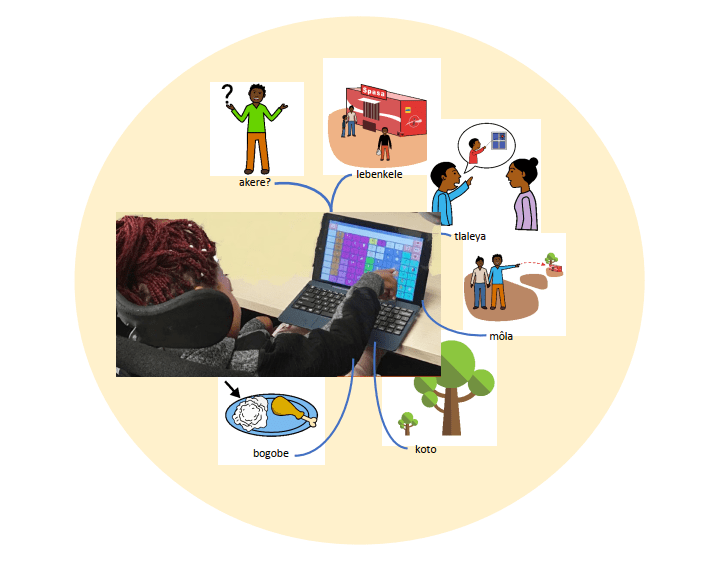18 May 2023
The implementation of alternative forms of communication for children who are not yet literate – especially those who have severe communication needs and require picture-based systems to express themselves – has always been a key research interest for Prof Kerstin Tönsing.
“Children who need such systems often have some physical disabilities which make them incapable of using sign language,” says Tönsing, who is a speech therapist, audiologist, and professor at the University of Pretoria’s Centre for Augmentative & Alternative Communication. “We provide them with picture-based systems that represent words which they can point to or activate on a device in order to convey their message,” she explains.
While this type of intervention has been widely used in the field of augmentative and alternative communication (AAC) to help individuals who cannot rely on their natural speech to communicate, and there are numerous picture-based vocabulary packages available for various languages, many of the so-called low-resource languages have been left behind. This is also true for many of the South African languages, including Sepedi.
“I started getting increasingly concerned that we are doing a lot of intervention in South Africa in English for children whose home language is not English,” Tönsing recalls. “We live in a multilingual country and children should be able to express themselves in their home language – this also applies to children who need a picture-based AAC system to do so. But, what are we doing to foster all of the children’s languages?”
Thanks to research funding from the South African Centre for Digital Language Resources (SADiLaR), this reality is about to change for Sepedi children. Tönsing and her team have embarked on a project to develop a research- and stakeholder-informed non-electronic AAC system for Sepedi. The aim is to design a comprehensive system with a range of vocabulary items that allow for language development.
Mother tongue communication
“The communication of preliterate children from a Sepedi (Sesotho sa Lebowa) language background is severely restricted as there currently is no AAC system available in their mother tongue – an estimated 80 000 Sepedi children are affected. A picture-based AAC system that allows for expression in Sepedi is therefore an urgent necessity,” Tönsing comments.
She is ideally placed to lead this research project as much of her PhD and postdoc research was centered around developing AAC systems that give access to non-English South African languages.
“The project builds on the Master’s research of Ngwanamashiane Rahab Mothapo, who is now a PHD student and an important collaborator,” Tönsing continues. “We established a core vocabulary list, based on the analysis of language samples of Sepedi preschoolers. We then identified graphic symbols from existing symbol libraries, which were validated and extended with stakeholders during in-depth discussions. Some additional symbols are currently being designed to represent some of the Sepedi core words for which we could not find suitable symbols.”
Human-centered design process
According to Tönsing, they also did a needs analysis and discussed design requirements with the stakeholder group, which comprises speech-language therapists with experience in AAC and providing services in the Sepedi language; parents of children with complex communication needs from a Sepedi background; adult users of AAC systems; and teachers who teach children from a Sepedi background, with severe communication disabilities. The participants are based mainly in the Limpopo Province where Sepedi is spoken.
All interactions with the focus groups are being transcribed and thematically analysed. The next step is to start a human-centered design process where the first prototype AAC system is shared with stakeholders for valuation. “We are on the brink of creating the first prototype, which is very exciting. It is an iterative process with stakeholders where we listen to their feedback and redesign until we reach a stage where the system is ready to be used. Even then, the feedback from users will be ongoing,” Tönsing says.
International conference
The results of the first phase of the project will be presented by Rahab Mothapo at the Biennial Conference of the International Society for Augmentative and Alternative Communication in Cancún, Mexico, from 24 to 27 July 2023. The conference, themed ‘Communication beyond borders’, will be attended by researchers, academics, practitioners and persons using AAC from across the world, and showcase the latest research and lived experiences in the field of AAC.
“It is such a privilege to be enabled by SaDiLaR to present research findings of such an important study that cuts through a number of disciplines,” Mothapo comments. “I am looking forward to sharing this information with the extremely diverse audience. This for me, marks a small attempt at making communication accessible to the Sepedi-speaking South African population living with communication impairment.”
Written by Birgit Ottermann
Image: (Credit: Mr Gustaf Tempelhoff and Prof Kerstin Tönsing)

